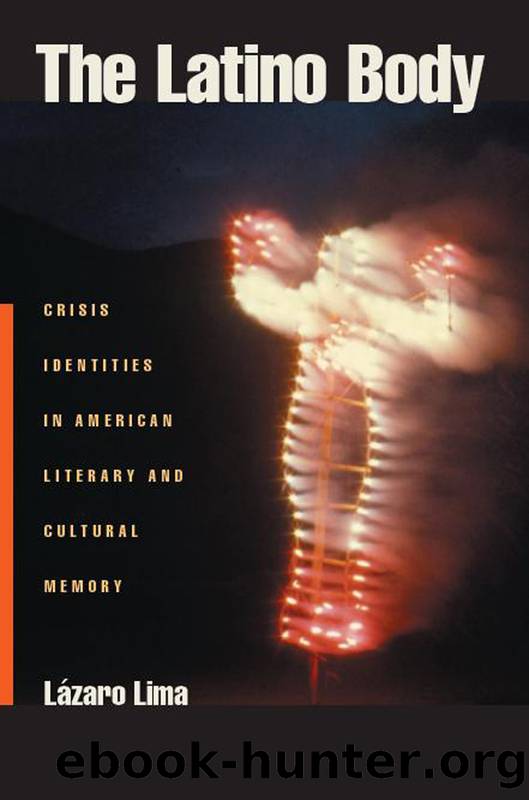The Latino Body by LÁZARO LIMA

Author:LÁZARO LIMA
Language: eng
Format: epub
Publisher: New York University Press
Published: 2007-06-15T00:00:00+00:00
In the âService of Your Majestyâ: Castaways and the Amerindian Body in the Colonial Imaginary of Villagrá
Cabeza de Vacaâs knowledge of the Amerindian peoplesâ âcustoms and stratagemsâ during his travails through New Mexico, offered to the king, was in fact valuable in the conquest and colonization of the American Southwest and the literature that charts this process. His text inspired the legend of âthe seven cities of Cibolaâ and served as the historical basis for Gaspar Pérez de Villagráâs 1610 Historia de la Nueva México (History of New Mexico), which chronicles the conquest of New Mexico by Juan de Oñate (c. 1550â1625). Oñateâs exploits began approximately fifty-six years after the first publication of Castaways and were hyperbolically celebrated by Villagrá, his procurador general and an eyewitness to the expedition.
Villagráâs History of New Mexico, dedicated to King Philip III,35 is one of the earliest epic poems written in New Spain and âmay claim the distinction of being the first published history of any American commonwealth.â36 The text covers the actual establishment of New Mexico by Juan de Oñate from 1598 to 1601, and chronicles the Oñate expeditionâs incursions through the New Mexican landscape and the attendant clashes with the Amerindians, specifically the Acoma tribe.37 From the prologue, Villagrá establishes the need to secure the practices of empire through writing, since â[n]o greater misfortune could possibly befall a people than to lack a historian properly to set down their annalsâ (Espinosa, 35). Writing will entail for Villagrá the preservation of Spanish âcultural memoryâ as antidote to cultural oblivion, âfor history not only brings before us those who are absent, but it resurrects and breathes life itself into those long dead. ⦠I take my pen, the first to set down these annals, more in response to that sense of duty I feel than in confidence in my abilityâ (ibid.).
Villagráâs History of New Mexico has been accorded the status of a historical document with the truth claims the designation carries: âit is a literary recreation that not only holds strictly to the historical events and their chronology, but introduces a very bare minimum of fictional materialâ (Encinias et al., introduction, xx). The assertion, aside from literalizing Villagráâs stated intentions, obviates a series of facts that ignore the historical conditions around the text and the textâs supporting suppositions about the Amerindian and Spanish characters that infuse the poem with historical meaning. Texts like Cabeza de Vacaâs Castaways are accorded a truth-bearing quality that is purportedly distinguishable from those rare moments where âfictional materialâ is said to be inserted. Indeed, in the editorsâ introduction to Villagráâs History of New Mexico, Encinias, RodrÃguez, and Sánchez state that â[i]f one discounts the almost necessary fictionalization of the Acoma world, to which the narrator had little access, Historia de la Nueva México interpolates no fictional passagesâ (xx).
If this is the case, then Villagrá relates a truncated world indeed. Relegating the Acoma to the status of fictional, while purporting to tell the ârealâ events lived by the Spanish, makes
Download
This site does not store any files on its server. We only index and link to content provided by other sites. Please contact the content providers to delete copyright contents if any and email us, we'll remove relevant links or contents immediately.
The Power of Myth by Joseph Campbell & Bill Moyers(1000)
Half Moon Bay by Jonathan Kellerman & Jesse Kellerman(950)
A Social History of the Media by Peter Burke & Peter Burke(935)
Inseparable by Emma Donoghue(921)
The Nets of Modernism: Henry James, Virginia Woolf, James Joyce, and Sigmund Freud by Maud Ellmann(832)
The Spike by Mark Humphries;(764)
The Complete Correspondence 1928-1940 by Theodor W. Adorno & Walter Benjamin(746)
A Theory of Narrative Drawing by Simon Grennan(741)
Culture by Terry Eagleton(710)
Ideology by Eagleton Terry;(696)
Bodies from the Library 3 by Tony Medawar(679)
World Philology by(673)
Farnsworth's Classical English Rhetoric by Ward Farnsworth(671)
Game of Thrones and Philosophy by William Irwin(668)
High Albania by M. Edith Durham(654)
Adam Smith by Jonathan Conlin(647)
A Reader’s Companion to J. D. Salinger’s The Catcher in the Rye by Peter Beidler(643)
Comic Genius: Portraits of Funny People by(616)
Monkey King by Wu Cheng'en(609)
